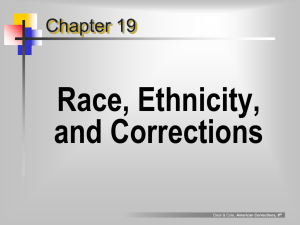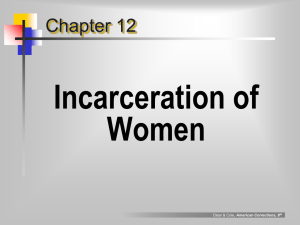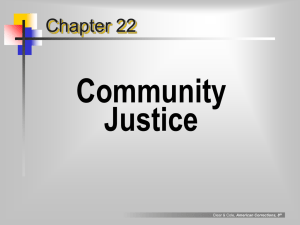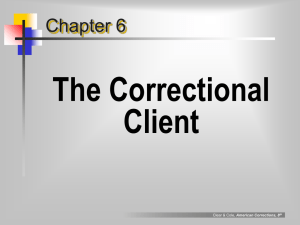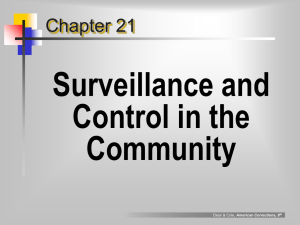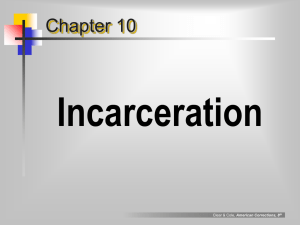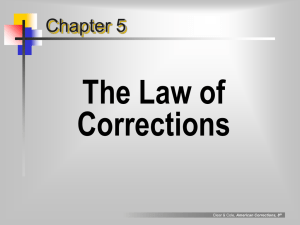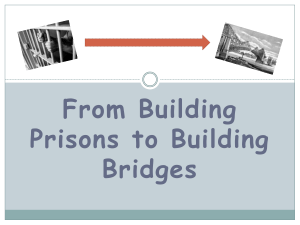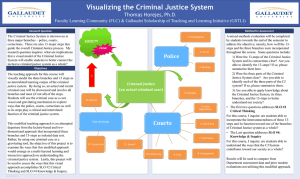Race, Ethnicity, and Corrections
advertisement
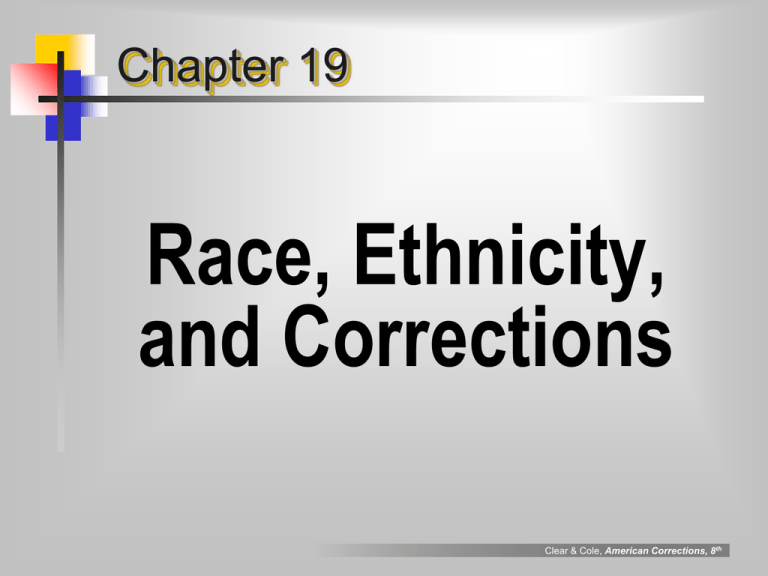
Chapter 19 Race, Ethnicity, and Corrections Clear & Cole, American Corrections, 8th Race, Ethnicity, and Corrections The Concepts of Race and Ethnicity Visions of Race and Punishment The View of Differential Criminality The View of a Racist Criminal Justice System The View of a Racist Society Which is it Race or Racism? The Significance of Race and Punishment Clear & Cole, American Corrections, 8th “race” traditionally, a biological concept used to distinguish humankind into categories related to skin color & other physical features Clear & Cole, American Corrections, 8th “ethnicity” concept used to distinguish people according to their cultural characteristics--language, religion, & group traditions ethnicity can be used to further distinguish not only among white individuals, but among African Americans, as well. it can also be used to even further subdivide Hispanics. Clear & Cole, American Corrections, 8th “disparity” the inequality of treatment of one group (compared to the treatment accorded other groups) by the criminal justice system disparity may be based on legal (e.g., criminal record) or illegal, or improper, (e.g., race) grounds Clear & Cole, American Corrections, 8th “discrimination” differential treatment of groups without reference to an individual’s behavior or qualifications Clear & Cole, American Corrections, 8th crime, race & ethnicity by the numbers fact: men of color, especially, young men, are disproportionately locked up in U.S. prisons & jails, or otherwise under control of the criminal justice system in America: 1/2 U.S. prison population is black black men are 7 times more likely than whites to have been incarcerated at some time in prison 1 in 3 black men in their 20s is under correctional supervision in U.S. 56% of young black men in Baltimore… 50% of black men 18-35 in D.C. Clear & Cole, American Corrections, 8th Racial Disparity in State Prison Systems Clear & Cole, American Corrections, 8th Explanations of racial disparity in criminal justice alternative views: why men of color are disproportionately represented in criminal justice system query: does disparity in criminal justice system amount to discrimination? differential criminality racist criminal justice system racist society they do more (serious) crimes, with more serious prior records, other characteristics warranting prison Clear & Cole, American Corrections, 8th “self-report study” an investigation of behavior (like criminal activity) based on subjects’ responses to questions concerning their involvement in those activities Clear & Cole, American Corrections, 8th Children in Poverty, by Race and Ethnicity Clear & Cole, American Corrections, 8th Average Family Income , 2004 Clear & Cole, American Corrections, 8th “Myths in Corrections” The Myth: The way families are affected by incarceration of young fathers is felt equally by all racial groups. The Reality: Almost one in ten (9.3%) of all African American children had a father in prison or jail, and this compares with 3.5% of Hispanic children and 1.2% of white children. Clear & Cole, American Corrections, 8th Explanations of racial disparity in criminal justice alternative views: why men of color are disproportionately represented in criminal justice system query: does disparity in criminal justice system amount to discrimination? differential criminality racist criminal justice system they do more (serious) crimes, with more serious prior records, other characteristics warranting prison incremental decisions all across criminal justice system work to their disadvantage; but no obvious racism racist society Clear & Cole, American Corrections, 8th Explanations of racial disparity in criminal justice alternative views: why men of color are disproportionately represented in criminal justice system query: does disparity in criminal justice system amount to discrimination? differential criminality racist criminal justice system racist society they do more (serious) crimes, with more serious prior records, other characteristics warranting prison incremental decisions all across criminal justice system work to their disadvantage; but no obvious racism criminal justice system is simply a reflection of racism in American society Clear & Cole, American Corrections, 8th evidence of broader racism crack cocaine (used in greater proportion by inner-city people of color) is punished 100 times more severely (by federal sentencing guidelines) than its virtually identical whitepowder equivalent (used in greater proportion by white offenders) stronger association between unemployment rates & imprisonment rates than between crime rates & imprisonment rates relationship between racism & criminal justice system may be reciprocal, perpetuating minority status & criminality Clear & Cole, American Corrections, 8th social significance of race and punishment opportunity costs for minority individuals cannot be earning a living cannot be attending school cannot be parenting cannot be voting and partaking of “free” society opportunity costs for minority communities alienation of entire generation of young adults from involvement & commitment to larger society social disruption, due to absence of major segment of its adult population generalized suspicion of criminal justice system by major portion of society Clear & Cole, American Corrections, 8th
